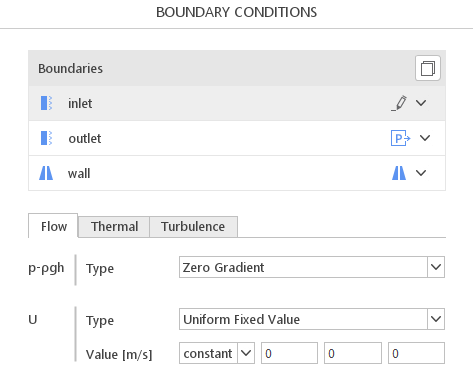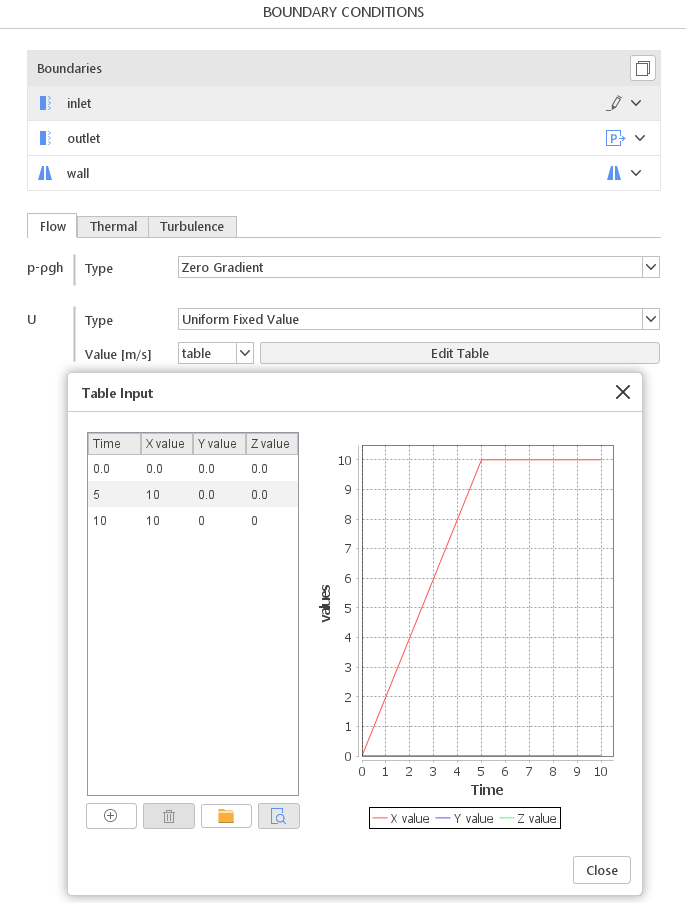Uniform Fixed Value - Boundary Condition Description
Uniform Fixed Value - is a derivative of Fixed Value boundary condition. It sets the field to the uniform value (throughout the entire boundary) as a constant value or as a function of time. The Uniform Fixed Value can be applied to all variable types (scalars, vectors).
Mathematically, the Uniform Fixed Value can be described as
Uniform Fixed Value - Boundary Condition Understanding Uniform Fixed Value
When the Uniform Fixed Value is applied, it enforces a specified value at the boundary. This value is uniformly applied to all mesh faces on the boundary, ensuring that it remains constant along the boundary. In other words, the specified field, such as temperature or velocity, remains constant across the boundary. This boundary condition is similar to Fixed Value. However, the key distinction is its ability to define time-dependent values at the boundary.
Uniform Fixed Value - Graphical Representation
The animation illustrates the temperature distribution in a long channel. The temperature at the left boundary varies over time between 300 K and 500 K, while the right boundary maintains a constant temperature of 300 K. The Uniform Fixed Value enables the definition of time-dependent profiles for various dependent variables, such as pressure, velocity, temperature, and turbulent properties.
Uniform Fixed Value - Boundary Condition Application & Physical Interpretation
The Uniform Fixed Value is one of the most commonly used boundary conditions. It consistently fixes the value of a specific variable at the domain boundary. However, its physical meaning varies depending on the problem being considered and the solver applied. Below are a few examples demonstrating how this boundary condition can be used and how to correctly interpret its meaning.
Uniform Fixed Value in Aerodynamics
Example applications: car, aircraft aerodynamics, wind tunnel experiment
This problem can be solved by using pimpleFoam (solver). This solver has two basic independent variables: pressure and velocity. Additionally, one can define turbulence-related variables. The Uniform Fixed Value can be applied at the inlet of the domain to represent changing in time value of the incoming air (therefore the speed of the car or aircraft).
| Physics | Velocity | Pressure |
|---|---|---|
Velocity Inlet | Uniform Fixed Value | Zero Gradient |
Pressure Outlet | Pressure Inlet Outlet Velocity | Uniform Fixed Value |
Uniform Fixed Value in Heat Transfer
Example applications: room ventilation, room heating, electronic cooling, atmospheric flows
When the flow is driven by buoyancy force, which arises from the density variation, the buoyantPimpleFoam (solver) can be used for such problem. The Uniform Fixed Value defines the temperature at a given boundary. This may represent, for example, the temperature of a hot radiator or the inlet temperature of air in a ventilation system.
| Physics | Velocity | Pressure | Thermal T |
|---|---|---|---|
Water inlet | Fixed Flux Pressure | Surface Normal Fixed Value | Uniform Fixed Value |
Uniform Fixed Value in Species Transport applications
Example applications: industrial furnaces, jet engines, chemical process industry (chemically reacting foams)
The reactingFoam (solver) can be applied for chemically reacting flows, that involve heat transfer and chemical reactions with the combustion. In this application, the Uniform Fixed Value boundary condition defines, for example, the gas composition at a given boundary.
| Physics | Velocity | Pressure | Species |
|---|---|---|---|
Air Inlet | Zero Gradient | Free Stream Velocity | Uniform Fixed Value |
Uniform Fixed Value - Boundary Condition How to apply Uniform Fixed Value in SimFlow
Constant value Uniform Fixed Value in SimFlow
When the constant value of variable is assigned using Uniform Fixed Value, the definition is similar to Fixed Value.

Time-dependent Uniform Fixed Value in SimFlow
The variable can be defined also as time-dependent. In SimFlow the convenient table with graphical representation is used to define the boundary condition.

Uniform Fixed Value - Boundary Condition Uniform Fixed Value - Alternatives
In this section, we propose boundary conditions that are alternative to Uniform Fixed Value. While they may fulfill similar purposes, they might be better suited for a specific application and provide a better approximation of physical world conditions.
| Boundary Condition | Description |
|---|---|
fixed value on the patch |